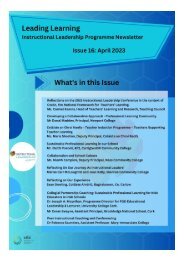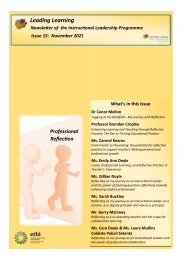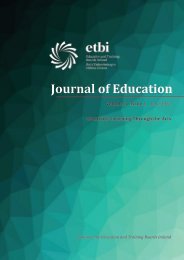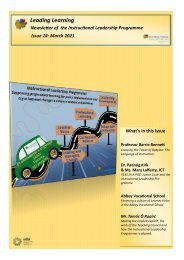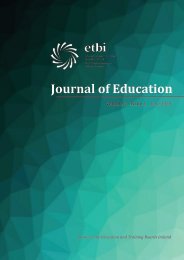ETBI Journal of Education - Vol 2:2 November 2020 (Irish-medium Education)
This bilingual edition of the Journal of Education celebrates Irish-medium Education
This bilingual edition of the Journal of Education celebrates Irish-medium Education
Create successful ePaper yourself
Turn your PDF publications into a flip-book with our unique Google optimized e-Paper software.
<strong>ETBI</strong> <strong>Journal</strong> <strong>of</strong> <strong>Education</strong> <strong>November</strong> <strong>2020</strong><br />
differences are not particularly significant when<br />
taking into account that IMS students tend to<br />
have a higher socio-economic status on average.<br />
As for national DEIS assessments, results show<br />
that progress has been made in DEIS schools<br />
nationwide in average literacy and numeracy<br />
scores from 2010 to 2016, but there is still a<br />
significant gap between the average national<br />
score and the national DEIS score. On that basis,<br />
this study raises the question, where do DEIS IMS<br />
stand in terms <strong>of</strong> achievement?<br />
THE LITERATURE<br />
Concern is <strong>of</strong>ten expressed in international<br />
literature about the educational<br />
underachievement <strong>of</strong> students from low socioeconomic<br />
backgrounds (Demie & Lewis, 2011;<br />
H<strong>of</strong>f, 2003, 2006; Sirin, 2005) and the effect <strong>of</strong><br />
the disadvantaged background on the learning <strong>of</strong><br />
the student (Chiu & McBride Chang, 2006; OECD,<br />
2010) and on the language development <strong>of</strong> the<br />
child (Molloy et al., 2016: 214). Certain studies<br />
suggest, for example, that the rate <strong>of</strong> vocabulary<br />
development is slower in children from<br />
disadvantaged backgrounds in the preschool<br />
period and that they will have a lower level <strong>of</strong><br />
attainment as they get older (Hart & Risley, 2003;<br />
Peers et al., 2000; Walker et al., 1994).<br />
Studies also discuss students who may be at risk<br />
in the immersion education system due to low<br />
ability in their first language (Genesee, 2004,<br />
2007; Genesee & Fortune, 2014), which may be<br />
related to socio-economic status. However, Bruck<br />
(1982) displayed that students who had language<br />
difficulties and who attended the immersion<br />
education system were just as successful as<br />
their peers in the L1 education system, but that<br />
they also attained a higher ability in the second<br />
language at the same time. As for the socioeconomic<br />
status <strong>of</strong> students, other studies have<br />
discovered that students from disadvantaged<br />
backgrounds in the immersion education system<br />
were at the same level <strong>of</strong> L1 development as<br />
students from the same backgrounds who were<br />
not attending the immersion education system<br />
(Bruck et al., 2015).<br />
METHODOLOGY<br />
Students from 3rd class and 6th class from 13<br />
DEIS IMS took part in the research. Standardised<br />
tests in English Reading (Drumcondra Sentence<br />
Reading Test) and in Mathematics were organised<br />
in each school in May 2017. The same tests were<br />
used as in the National DEIS Assessment (Weir<br />
& Denner, 2013; Kavanagh, Weir & Moran, 2017)<br />
so that a comparison could be made between the<br />
test scores in the current study and the national<br />
DEIS scores in order to assess any differences in<br />
achievements.<br />
PRIMARY RESEARCH RESULTS<br />
Reading Attainment in English<br />
In Band 2 DEIS IMS schools, 3rd class and 6th<br />
class demonstrated a higher average score than<br />
the national DEIS score, although the difference<br />
was only significant at third class level. In Band<br />
1, the average score in third class DEIS IMS was<br />
somewhat lower than the national DEIS score,<br />
however by the end <strong>of</strong> the primary school cycle<br />
students in DEIS IMS were achieving much higher<br />
scores than DEIS schools nationally. The weaker<br />
results in 3rd class, which then rise by 6th<br />
class, could be explained by a temporary delay<br />
in the bilingual system, which dissipates over<br />
time when students begin reading in their first<br />
PAGE 70




